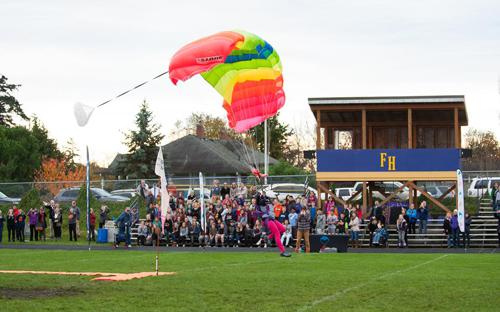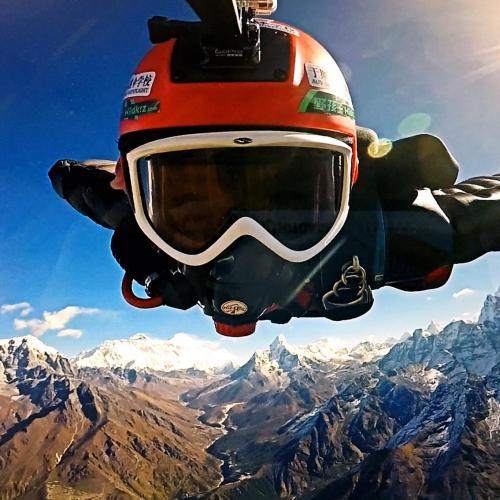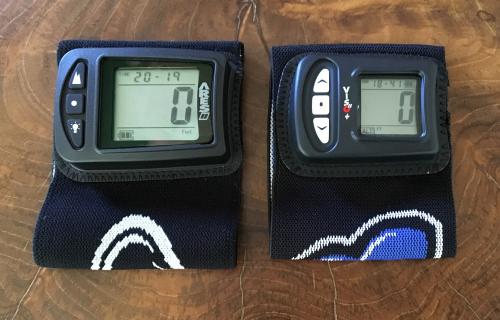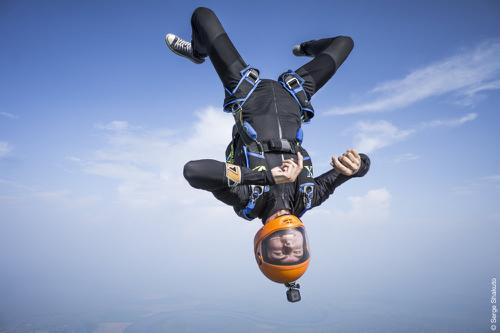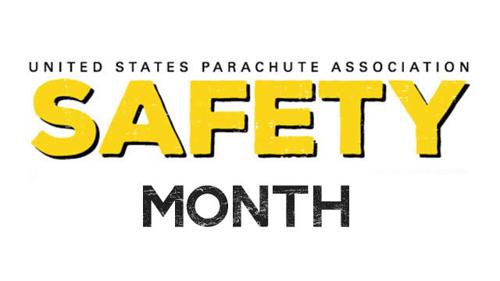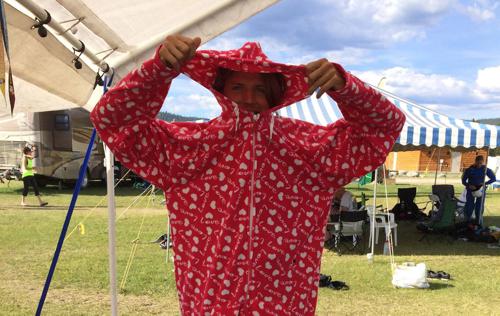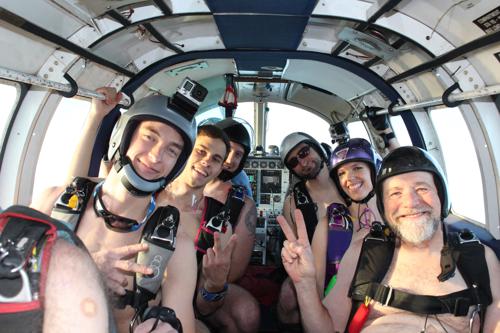Demo Skydiving for N00bs
How To Be A Hero, Kinda
Maybe you’re a limelight magnet and maybe you’re not-- but if you like to mess around with parachutes, the limelight might follow you regardless. Even if you don’t necessarily seek it out, there’s a chance that someone will find out you’re a skydiver and ask you to--well--jump into something. A grand opening, for instance, or a wedding, or a local event.
Before you slink away, hold on! If you’ve got the experience under your belt, there’s really no reason to turn it down out-of-hand. This could be a great learning experience if you’re able to commit the time and wherewithal to put in the planning. Expanding your skill as a jumper is always a worthwhile endeavor.
After all, a demo (or, as it is officially known, an exhibition/display jump) doesn’t have to be a stressful proposition. Unless you’re Kenyon Salo (or anyone else on the Denver Broncos Thunderstorm team), it doesn’t necessarily stipulate a nail-biting night jump that swoops you through a spiderweb of cables to a landing in front of a screaming stadium audience. It may surprise you that, for demo jumps performed under specific conditions, you don’t need a USPA D-license or a pro rating. Spoiler alert: It doesn’t even necessarily mean that you’re landing in front of an audience. Doing a demo jump simply means that you’re jumping into a location other than an official registered drop zone.
To get a little clarity, I talked to Neil Amonson, who has been a demo jumper par excellence for quite some time. Once a member of the legendary GoPro Bomb Squad, Neil now runs Jump For Joy--an incredible skydiving-driven inspirational/educational youth project. (You should stop scrolling right now and sign up.) For a little help getting your homework started, read on.
Give It Time
A demo starts -- of course -- on the ground. If you’re approaching the idea of doing a demo jump for the first time, you should give yourself about a month’s worth of lead time to make all the necessary arrangements and file paperwork. Aside from the not-insignificant challenge of finding an aircraft to do the deed, you can expect more than a few checklists to work through, the details of which change according to the details of your unique jump plan.
Determine Your Level.
If you skew to the new, you’re very likely going to find your footing as a Level One or “Open Field” demo jumper.
While the experience and license requirements are the same between the two. but Level One and Open Field jumps are classified differently based on area. If the landing area covers up to 500,000 square feet, the landing area is classified as Level One. If it clocks in at more than 500,000 square feet, that’s when it becomes a "open field.”
“There are some little details between the two that makes a Level One slightly more advanced,” Neil explains. “For my jumps, when I measure up the LZ and see how many square feet it is, that lets me know how complex of a demo it is likely to be. ‘Open field’ is a piece of cake and very low stress. Level 1 is still pretty easy, but I probably couldn’t do it blindfolded. Level Two is more serious--and a stadium usually has my butt a little puckered.”
“Because it shows up on the paperwork, I think the level system helps the FAA understand how much risk is involved,” he adds. “The lower the level of the LZ, the less they probably stress about the jump as well.”
To jump into a Level One or Open Field LZ, you’re going to need at least a USPA C license and 200 jumps in your logbook, 50 of which must have been made within the past 12 months and five of which need to have been done on the same model and size canopy you’re planning to use on the demo.
If you’re significantly more seasoned, you can hook up with an Instructor-Examiner and get your PRO rating to do Level Two demos. This is the rating you’ll need to jump into any stadium, no matter now big. (Ask anybody who has jumped into a stadium why that’s the case, and they’ll probably tell a rotor story that’ll curl your hair.)
Assess the Landing Area
If you’re considering a demo, your first stop should be a technical requisition of the landing area. (If this wasn’t going to be the top item on your list in the absence of advice, we would perhaps recommend binning the idea of a demo entirely.)
If you’re a level-one demo jumper, you’ll need loads of room. You’ll soon see why the “open field” moniker applies. For a Level One jump, you’ll need to be jumping into a landing area no smaller than 250,000 square feet. When you’re jumping into an area over 500,000 square feet, you’re in an “open field.” Most open-field athletic areas constitute a Level One area.
That might sound enormous--and it is, at a minimum of 500’x500’--but don’t sniff too soon. The additional stresses of a demo jump are going to make the experience sufficiently interesting to hold your attention.
Get The Rest of Those Ducks In a Row
After you’ve collected all your in-date identification (specifically, your parachuting license and reserve repack card) for presentation, you’ll be working with the aircraft operator to do the paperwork. Get ready to leap into the exciting world of waivers, any required secondary insurances and the holy NOTAM.
Let’s take a second to define “NOTAM,” if this is the first time you’ve come across the term. NOTAM is an acronym that stands for “Notice to Airmen.”* A NOTAM is, essentially, a heads-up to pilots and the FAA at large that flags what you’re up to in the airspace. A NOTAM allows you and your aircraft to fly a stated altitude and pattern within a stated time window. As well as Google Maps, you’ll also be using a website called Skyvector to complete your filing, because the FAA will want see your LZ on a sectional chart as well as a satellite image.
It’s important to note that a NOTAM is not a guarantee that your jump’s gonna happen. It can be turned down by the FAA. Neil suggests filing a 7711-2, also called the "Application for Certificate of Waiver or Authorization,” no matter what level of demo you’re planning.
“While it's not required for Open Field and Level One landing areas, it's the one piece of the puzzle that absolutely ensures that everyone that needs to be on board is on board,” he explains. “It's basically the golden ticket from the FAA that says ‘we approve of your plan.’ I used to try and skirt the rules for doing the paperwork and--even though I was legal!--one time, the FAA called my pilot and told them not to let me jump because we disagreed on what type of landing zone it was. Ever since then, I’ve done a 7711-2 for every demo and I haven't had one turned down in ten years.”
While page 169 of the SIM explains how to fill out a 7711-2, Neil says that a little mentorship will go a long way.
“The best way to learn how to fill it out is to have a local pro-rated jumper--who has filled one out before--let you see one they’ve submitted,” he explains. “If you were just to look at the application, it’s kind of confusing, but when you see it filled out it makes more sense.”
Take note: The higher-profile your jump, the more likely it is that the FAA will come out and watch to make sure you didn't ask permission for one thing and then do another.
Dial In Your Comms and Your Crowd Control
You’ll need to conspire with a ground crew to manage your adoring crowd in accordance with the guidelines in the SIM (unless you’ve figured something else out and gotten it officially waivered). For Level One demo jumps, the crowd management suggested by the USPA allows skydivers to drift over the spectators with sufficient altitude (250 feet) to prevent a hazard to anything or anyone on the ground. (That means you’ll be landing at least 50 feet from the spectators. The USPA, in its benevolent wisdom, doesn’t want you toddler-bowling.)
“A rule that is often forgotten about,” Neil warns, “is the requirement for ground-to-air communications between the ground crew and aircraft. This is easy accomplished with a radio--or even texting, when you’re only going up to hop-and-pop altitude.”
“There also needs to be a backup, if those comms are lost,” he adds, “that can signal to the jumpers that the LZ is not safe. That’s your ‘no comms’ plan. On my demos, the ground crew usually puts a big X down where we are supposed to land. We tell the ground crew that, if we lose comms and we should NOT jump, to remove the X from the LZ. If we look out of the plane and don't see the X marking the spot, we know something happened, and to stay in the plane. In all the years I’ve been doing demos, we've never actually needed to do this, but it's good that your ground crew knows, in case the FAA shows up, to make sure you are sticking to your plan.”
...And Don’t Jump When It’s Not Jumpable
Great! So you have your filings approved, your ground crew is stoked, your crowd is assembled and your prop is turning...but the trees are bending over more than a little bit at the top and there’s weather creeping in. The USPA recommends a maximum wind of 15 mph for a demo jump. What now?
“The hardest part of a demo just is knowing when NOT to jump,” Neil notes. “It is soooo hard to say no when it's game day and you just want to pull it off the winds are strong and gusty.”
“Also watch out for the winds aloft,” he insists. “Your spot is everything. There have been a few times I've done demos where we’ve drifted into the next county, and that always happened because it was calm on the ground but NUKING up high-- our pilot wasn't a jump pilot so he didn't think it was important--and we mistakenly assumed that calm winds on the ground meant calm winds above the ground. Whoops.”
Use Your New Skills For Good>
Demo skydiving inspires people. It does! There’s something semi-magical about descending from on high and (hopefully) touching down like goddamn Tinkerbell in front of a cheering crowd. That crowd’s general concept of what-is-possible for themselves, the world and physics will change, at least a little bit, for the good...and that’s almost certainly worth the effort of prep and paperwork. N’est-ce pas?
*This author looks forward to a verbiage change away from crusty old gendered language. “Notice To Airpersons,” perhaps?

